#changmiania
Explore tagged Tumblr posts
Text
DMM ROUND FOUR MASTERPOST
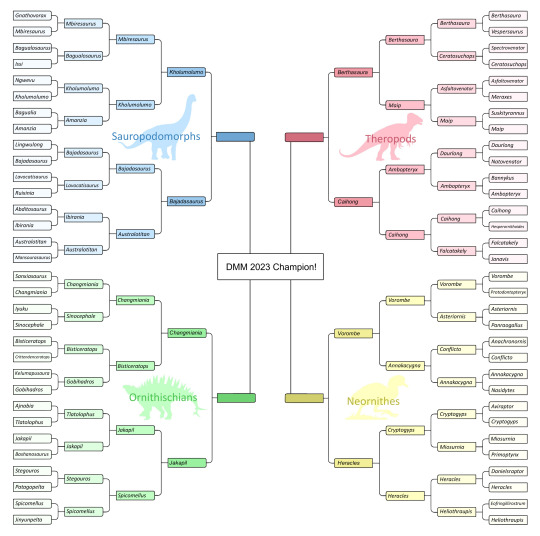
ORNITHISCHIAN FINAL MATCHUP:
Changmiania vs Jakapil
SAUROPODOMORPH FINAL MATCHUP:
Kholumolumo vs Bajadasaurus
NON-NEORNITHINE THEROPOD FINAL MATCHUP:
Berthasaura vs Caihong
NEORNITHINE FINAL MATCHUP:
Vorombe vs Heracles
REBLOG! SHARE! DEBATE!
IT'S DINOSAUR MARCH MADNESS!
#dmm#dmm rising stars#dinosaur march madness#dinosaurs#birds#bracket#march madness#palaeoblr#birblr#paleontology#polls#round four#changmiania#jakapil#kholumolumo#bajadasaurus#berthasaura#caihong#vorombe#heracles
235 notes
·
View notes
Text
Changmiania😴
335 notes
·
View notes
Note
you like dinos? name every dino
Aardonyx Abdarainurus Abelisaurus Abrictosaurus Abrosaurus Abydosaurus Acantholipan Acanthopholis Achelousaurus Acheroraptor Achillesaurus Achillobator Acristavus Acrocanthosaurus Acrotholus Adamantisaurus Adasaurus Adelolophus Adeopapposaurus Adratiklit Adynomosaurus Aegyptosaurus Aeolosaurus Aeolosaurus Aepyornithomimus Aerosteon Afromimus Afrovenator Agathaumas Agilisaurus Agrosaurus Agujaceratops Agujaceratops Agustinia Ahshislepelta Ajkaceratops Ajnabia Akainacephalus Alamitornis Alaskacephale Albalophosaurus Albertaceratops Albertadromeus Albertavenator Albertonykus Albertosaurus Albinykus Alcmonavis Alcovasaurus Alectrosaurus Aletopelta Algoasaurus Alioramus Alioramus Allosaurus Allosaurus Allosaurus Almas Alnashetri Altirhinus Altispinax Alvarezsaurus Alxasaurus Amanzia Amargasaurus Amargatitanis Amazonsaurus Ambiortus Ambopteryx Ampelosaurus Amphicoelias Amtocephale Amurosaurus Amygdalodon Anabisetia Analong Anasazisaurus Anchiceratops Anchiornis Anchisaurus Andesaurus Angolatitan Angulomastacator Anhuilong Aniksosaurus Animantarx Ankylosaurus Anodontosaurus Anomalipes Anoplosaurus Anserimimus Antarcticavis Antarctopelta Antarctosaurus Antarctosaurus Antarctosaurus Antarctosaurus Antetonitrus Antrodemus Anzu Aoniraptor Aorun Apatoraptor Apatornis Apatosaurus Apatosaurus Appalachiosaurus Apsaravis Aquilarhinus Aquilops Arackar Aragosaurus Aralosaurus Aratasaurus Archaeoceratops Archaeoceratops Archaeodontosaurus Archaeopteryx Archaeopteryx Archaeorhynchus Archaeornithoides Archaeornithomimus Archaeornithomimus Archaeornithura Arcovenator Arcusaurus Arenysaurus Argentinosaurus Argyrosaurus Aristosuchus Arkansaurus Arkharavia Arrhinoceratops Arrudatitan Asfaltovenator Asiaceratops Asiaceratops Asiahesperornis Asiatosaurus Asiatosaurus Astrophocaudia Asylosaurus Atacamatitan Atlantosaurus Atlantosaurus Atlasaurus Atlascopcosaurus Atrociraptor Atsinganosaurus Aublysodon Aucasaurus Augustynolophus Auroraceratops Aurornis Australodocus Australotitan Australovenator Austrocheirus Austroposeidon Austroraptor Austrosaurus Avaceratops Aviatyrannis Avimimus Avimimus Avisaurus
Baalsaurus Bactrosaurus Bactrosaurus Bagaceratops Bagaraatan Bagualia Bagualosaurus Bahariasaurus Bainoceratops Bainoceratops Bajadasaurus Balaur Bambiraptor Banji Bannykus Baotianmansaurus Baptornis Barapasaurus Barilium Barosaurus Barrosasaurus Barsboldia Baryonyx Bashanosaurus Batyrosaurus Batyrosaurus Baurutitan Bauxitornis Bayannurosaurus Beg Beibeilong Beiguornis Beipiaognathus Beipiaosaurus Beishanlong Bellusaurus Berberosaurus Berthasaura Bicentenaria Bienosaurus Bissektipelta Bistahieversor Blasisaurus Blikanasaurus Bohaiornis Bolong Boluochia Bonapartenykus Bonapartenykus Bonapartesaurus Bonatitan Bonitasaura Borealopelta Borealosaurus Boreonykus Borogovia Bothriospondylus Brachiosaurus Brachyceratops Brachylophosaurus Brachytrachelopan Bradycneme Brasilotitan Bravasaurus Bravoceratops Breviceratops Brighstoneus Brodavis Brodavis Brodavis Brodavis Brohisaurus Brontomerus Brontosaurus Buitreraptor Burianosaurus Buriolestes Byronosaurus
Caenagnathasia Caenagnathus Caihong Calamosaurus Callovosaurus Camarasaurus Camarasaurus Camarasaurus Camarasaurus Camarillasaurus Camelotia Camposaurus Camptodontornis Camptosaurus Campylodoniscus Canadaga Canardia Carcharodontosaurus Carcharodontosaurus Cardiodon Carnotaurus Caseosaurus Cathartesaura Caudipteryx Caudipteryx Cedarosaurus Cedarpelta Cedrorestes Centrosaurus Ceramornis Cerasinops Ceratonykus Ceratops Ceratosaurus Ceratosaurus Ceratosaurus Ceratosuchops Cerebavis Cetiosauriscus Cetiosaurus Changchengornis Changchunsaurus Changmiania Changyuraptor Changzuiornis Chaoyangia Chaoyangsaurus Charonosaurus Chasmosaurus Chasmosaurus Chasmosaurus Chebsaurus Chenanisaurus Chialingosaurus Chiappeavis Chiayusaurus Chiayusaurus Chilantaisaurus Chilesaurus Chindesaurus Chingkankousaurus Chinshakiangosaurus Chirostenotes Choconsaurus Chondrosteosaurus Chongmingia Choyrodon Chromogisaurus Chuandongocoelurus Chuanjiesaurus Chuanqilong Chubutisaurus Chungkingosaurus Chupkaornis Chuxiongosaurus Cimolopteryx Cimolopteryx Citipati Citipes Claosaurus Coahuilaceratops Coelophysis Coelurus Colepiocephale Coloradisaurus Comahuesaurus Compsognathus Compsosuchus Concavenator Conchoraptor Concornis Condorraptor Confuciusornis Confuciusornis Confuciusornis Confuciusornis Convolosaurus Coronosaurus Corythoraptor Corythosaurus Corythosaurus Craspedodon Craterosaurus Cretaaviculus Crichtonpelta Crichtonsaurus Cristatusaurus Crittendenceratops Cruxicheiros Cryolophosaurus Cumnoria
Dacentrurus Daemonosaurus Dakotadon Dakotaraptor Dalianraptor Daliansaurus Dandakosaurus Daspletosaurus Daspletosaurus Datanglong Datonglong Datousaurus Daurlong Daxiatitan Deinocheirus Deinodon Deinonychus Deltadromeus Demandasaurus Denversaurus Diabloceratops Diamantinasaurus Dicraeosaurus Dilong Dilophosaurus Diluvicursor Dineobellator Dinheirosaurus Diplodocus Diplodocus Diplodocus Dongbeititan Dongyangopelta Dongyangosaurus Draconyx Dracoraptor Dracovenator Dreadnoughtus Dromaeosauroides Dromaeosaurus Dromiceiomimus Drusilasaura Dryosaurus Dryptosaurus Dubreuillosaurus Duriatitan Duriavenator Dynamoterror Dyoplosaurus Dysalotosaurus Dysganus Dysganus Dysganus Dysganus Dyslocosaurus Dzharaonyx Dzharatitanis
Echinodon Edmontonia Edmontonia Edmontosaurus Edmontosaurus Efraasia Einiosaurus Ekrixinatosaurus Elaltitan Elaphrosaurus Elmisaurus Elopteryx Elrhazosaurus Emausaurus Enaliornis Enaliornis Enaliornis Enantiophoenix Enigmosaurus Eoabelisaurus Eocarcharia Eoconfuciusornis Eocursor Eodromaeus Eogranivora Eolambia Eomamenchisaurus Eoraptor Eosinopteryx Eotrachodon Eotriceratops Eotyrannus Eousdryosaurus Epachthosaurus Epanterias Epichirostenotes Epidexipteryx Equijubus Erectopus Erketu Erliansaurus Erlikosaurus Erythrovenator Eshanosaurus Eucamerotus Eucercosaurus Eucnemesaurus Eucnemesaurus Euhelopus Euoplocephalus Europasaurus Europatitan Europelta Euskelosaurus Eustreptospondylus Evgenavis Evgenavis
Falcarius Falcatakely Ferganasaurus Ferrisaurus Foraminacephale Fosterovenator Fostoria Fruitadens Fukuipteryx Fukuiraptor Fukuisaurus Fukuititan Fukuivenator Fulgurotherium Fumicollis Fushanosaurus Fusuisaurus Futalognkosaurus Fylax
Galeamopus Galeamopus Galleonosaurus Gallimimus Gallornis Galvesaurus Gannansaurus Gansus Gansus Ganzhousaurus Gargantuavis Gargoyleosaurus Garrigatitan Garudimimus Gasosaurus Gasparinisaura Gastonia Gastonia Geminiraptor Genusaurus Genyodectes Geranosaurus Gettyia Gideonmantellia Giganotosaurus Gigantoraptor Gigantspinosaurus Gilmoreosaurus Gilmoreosaurus Gilmoreosaurus Gilmoreosaurus Giraffatitan Glacialisaurus Glishades Glyptodontopelta Gnathovorax Gobihadros Gobioolithus Gobioolithus Gobipteryx Gobiraptor Gobisaurus Gobititan Gobivenator Gojirasaurus Gondwanatitan Gongpoquansaurus Gongxianosaurus Gorgosaurus Goyocephale Graciliceratops Graciliraptor Gravitholus Gryphoceratops Gryposaurus Gryposaurus Gryposaurus Gryposaurus Guaibasaurus Gualicho Guanlong Guemesia
Hadrosaurus Haestasaurus Hagryphus Halimornis Halszkaraptor Hamititan Hanssuesia Haplocanthosaurus Haplocanthosaurus Haplocheirus Harpymimus Haya Heptasteornis Herrerasaurus Hesperonychus Hesperornis Hesperornis Hesperornis Hesperornis Hesperornis Hesperornis Hesperornis Hesperornis Hesperornis Hesperornis Hesperornis Hesperornithoides Hesperosaurus Heterodontosaurus Hexing Hexinlusaurus Heyuannia Hippodraco Histriasaurus Hollanda Homalocephale Hongshanornis Hoplitosaurus Horshamosaurus Hortalotarsus Huabeisaurus Hualianceratops Huallasaurus Huanansaurus Huanghetitan Huangshanlong Huaxiagnathus Huayangosaurus Hudiesaurus Huehuecanauhtlus Huinculsaurus Hulsanpes Hungarosaurus Hylaeosaurus Hypacrosaurus Hypacrosaurus Hypselosaurus Hypselospinus Hypsilophodon
Iaceornis Iberospinus Ibirania Ichthyornis Ichthyovenator Ignavusaurus Iguanacolossus Iguanodon Iguanodon Iguanodon Ilokelesia Imperobator Incisivosaurus Indosaurus Indosuchus Ingentia Intiornis Invictarx Irisosaurus Irritator Isaberrysaura Isanosaurus Isasicursor Ischioceratops Isisaurus Issi Itapeuasaurus Itemirus Iuticosaurus Iyuku
Jainosaurus Jakapil Jaklapallisaurus Janenschia Jaxartosaurus Jeholornis Jeholornis Jeholornis Jeholosaurus Jeyawati Jianchangornis Jianchangosaurus Jiangjunosaurus Jiangshanosaurus Jiangxisaurus Jianianhualong Jibeinia Jinbeisaurus Jinfengopteryx Jingshanosaurus Jinguofortis Jintasaurus Jinyunpelta Jinzhousaurus Jiuquanornis Jiutaisaurus Jixiangornis Jobaria Judiceratops Judinornis Juratyrant Juravenator
Kaatedocus Kaijiangosaurus Kaijutitan Kakuru Kamuysaurus Kangnasaurus Kansaignathus Kaririavis Karongasaurus Katepensaurus Kayentavenator Kazaklambia Kelmayisaurus Kelumapusaura Kentrosaurus Kerberosaurus Khaan Khinganornis Kholumolumo Khulsanurus Kileskus Kinnareemimus Klamelisaurus Kol Kompsornis Kookne Koparion Koreaceratops Koreanosaurus Koshisaurus Kosmoceratops Kotasaurus Kritosaurus Kryptops Kulceratops Kulindadromeus Kunbarrasaurus Kundurosaurus Kuru Kurupi Kuszholia
Labocania Laevisuchus Laiyangosaurus Lajasvenator Lamarqueavis Lamarqueavis Lamarqueavis Lambeosaurus Lambeosaurus Lambeosaurus Lanzhousaurus Lapampasaurus Laplatasaurus Lapparentosaurus Laquintasaura Latenivenatrix Latirhinus Latirhinus Lavocatisaurus Leaellynasaura Ledumahadi Leinkupal Leonerasaurus Lepidus Leptoceratops Leptorhynchos Leshansaurus Lesothosaurus Lessemsaurus Levnesovia Lexovisaurus Leyesaurus Liaoceratops Liaoningosaurus Liaoningotitan Liaoningvenator Ligabueino Ligabuesaurus Liliensternus Limaysaurus Limenavis Limusaurus Lingwulong Lingyuanosaurus Linhenykus Linheraptor Linhevenator Lirainosaurus Liubangosaurus Llukalkan Lohuecotitan Longicrusavis Longipteryx Longirostravis Longusunguis Lophorhothon Lophostropheus Loricatosaurus Losillasaurus Lourinhasaurus Luanchuanraptor Lucianovenator Lufengosaurus Lufengosaurus Luoyanggia Lurdusaurus Lusotitan Lusovenator Lycorhinus Lythronax
Maaqwi Machairasaurus Machairoceratops Macrocollum Macrogryphosaurus Macrurosaurus Macrurosaurus Magnamanus Magnapaulia Magnosaurus Magyarosaurus Magyarosaurus Mahakala Mahuidacursor Maiasaura Maip Majungasaurus Malarguesaurus Malawisaurus Maleevus Mamenchisaurus Mamenchisaurus Mamenchisaurus Mamenchisaurus Mamenchisaurus Mamenchisaurus Manidens Mantellisaurus Mapusaurus Maraapunisaurus Marmarospondylus Marshosaurus Martharaptor Masiakasaurus Massospondylus Massospondylus Matheronodon Maxakalisaurus Mbiresaurus Medusaceratops Megalosaurus Megapnosaurus Megapnosaurus Megaraptor Mei Melanorosaurus Mendozasaurus Menefeeceratops Mengciusornis Menucocelsior Meraxes Mercuriceratops Meroktenos Metriacanthosaurus Microceratus Microceratus Micropachycephalosaurus Microraptor Microraptor Microraptor Microvenator Mierasaurus Minmi Minotaurasaurus Miragaia Mirarce Mirischia Mnyamawamtuka Moabosaurus Mochlodon Mochlodon Mongolostegus Monkonosaurus Monolophosaurus Mononykus Montanoceratops Morelladon Moros Morrosaurus Mosaiceratops Murusraptor Mussaurus Muttaburrasaurus Muyelensaurus Mymoorapelta Mystiornis
Naashoibitosaurus Nambalia Nankangia Nanningosaurus Nanosaurus Nanshiungosaurus Nanuqsaurus Nanyangosaurus Narambuenatitan Narindasaurus Nasutoceratops Natovenator Navajoceratops Nebulasaurus Nedcolbertia Nedoceratops Neimongosaurus Nemegtomaia Nemegtonykus Neogaeornis Neosodon Neovenator Neuquenornis Neuquenraptor Ngwevu Nhandumirim Niebla Nigersaurus Ningyuansaurus Ninjatitan Niobrarasaurus Nipponosaurus Noasaurus Nodocephalosaurus Nodosaurus Nomingia Nopcsaspondylus Normanniasaurus Notatesseraeraptor Nothronychus Notoceratops Notocolossus Notohypsilophodon Nqwebasaurus Nullotitan Nuthetes
Oceanotitan Ohmdenosaurus Ojoceratops Ojoraptorsaurus Oksoko Olorotitan Omeisaurus Omeisaurus Omeisaurus Omeisaurus Omeisaurus Omeisaurus Omeisaurus Omeisaurus Omnivoropteryx Ondogurvel Oohkotokia Oplosaurus Orkoraptor Ornatops Ornitholestes Ornithomimus Ornithomimus Ornithomimus Ornithopsis Orodromeus Orthomerus Oryctodromeus Osmakasaurus Ostafrikasaurus Ostromia Ouranosaurus Overoraptor Overosaurus Oviraptor Owenodon Oxalaia Ozraptor
Pachycephalosaurus Pachyrhinosaurus Pachyrhinosaurus Pachyrhinosaurus Padillasaurus Palaeopteryx Palintropus Paludititan Pampadromaeus Pamparaptor Panamericansaurus Pandoravenator Panguraptor Panoplosaurus Panphagia Pantydraco Papiliovenator Parabohaiornis Parahesperornis Parahesperornis Parahongshanornis Paralitherizinosaurus Paranthodon Parapengornis Pararhabdodon Parasaurolophus Parasaurolophus Parasaurolophus Paraxenisaurus Pareisactus Parksosaurus Paronychodon Paronychodon Parvicursor Pasquiaornis Pasquiaornis Patagonykus Patagonykus Patagopteryx Patagosaurus Patagotitan Pawpawsaurus Pectinodon Pedopenna Pegomastax Pelecanimimus Pellegrinisaurus Peloroplites Pelorosaurus Pendraig Penelopognathus Pengornis Pentaceratops Perijasaurus Petrobrasaurus Phaedrolosaurus Philovenator Phuwiangosaurus Phuwiangvenator Phyllodon Piatnitzkysaurus Pilmatueia Pinacosaurus Pinacosaurus Piscivoravis Pitekunsaurus Piveteausaurus Planicoxa Plateosaurus Plateosaurus Plateosaurus Platypelta Plesiohadros Pneumatoraptor Poekilopleuron Polacanthus Polarornis Polyodontosaurus Polyonax Potamornis Powellvenator Pradhania Prenocephale Prenoceratops Priconodon Proa Probactrosaurus Probrachylophosaurus Proceratosaurus Procompsognathus Proornis Propanoplosaurus Prosaurolophus Protarchaeopteryx Protoceratops Protoceratops Protognathosaurus Protohadros Psittacosaurus Psittacosaurus Psittacosaurus Psittacosaurus Psittacosaurus Psittacosaurus Psittacosaurus Psittacosaurus Psittacosaurus Psittacosaurus Psittacosaurus Psittacosaurus Pterospondylus Puertasaurus Pukyongosaurus Pulanesaura Punatitan Pycnonemosaurus Pyroraptor
Qantassaurus Qianzhousaurus Qiaowanlong Qijianglong Qinlingosaurus Qiupalong Qiupanykus Quetecsaurus Quilmesaurus
Rahiolisaurus Rahonavis Rajasaurus Rapator Rapaxavis Rapetosaurus Raptorex Ratchasimasaurus Rativates Rayososaurus Rebbachisaurus Regaliceratops Regnosaurus Rhabdodon Rhabdodon Rhadinosaurus Rhinorex Rhoetosaurus Rhomaleopakhus Riabininohadros Rinchenia Rinconsaurus Riojasaurus Riparovenator Rugocaudia Rugops Rukwatitan Ruyangosaurus
Sahaliyania Saichania Saltriovenator Sanjuansaurus Sanpasaurus Santanaraptor Sanxiasaurus Sapeornis Sarahsaurus Sarcosaurus Sarmientosaurus Saturnalia Saurolophus Saurolophus Sauroniops Sauropelta Saurophaganax Sauroplites Sauroposeidon Saurornithoides Saurornitholestes Saurornitholestes Savannasaurus Scansoriopteryx Scelidosaurus Schizooura Schleitheimia Scipionyx Sciurumimus Scolosaurus Scolosaurus Scutellosaurus Secernosaurus Sefapanosaurus Segisaurus Segnosaurus Seitaad Sektensaurus Serendipaceratops Serikornis Shamosaurus Shanag Shantungosaurus Shanweiniao Shanxia Shanyangosaurus Shaochilong Shengjingornis Shenqiornis Shenzhousaurus Shidaisaurus Shingopana Shishugounykus Shixinggia Shri Shuangbaisaurus Shuangmiaosaurus Shunosaurus Shuvuuia Siamodon Siamosaurus Siamotyrannus Siamraptor Siats Sibirotitan Sierraceratops Sigilmassasaurus Silvisaurus Similicaudipteryx Sinocalliopteryx Sinocephale Sinoceratops Sinornithoides Sinornithomimus Sinornithosaurus Sinornithosaurus Sinosauropteryx Sinosaurus Sinosaurus Sinotyrannus Sinovenator Sinraptor Sinraptor Sinusonasus Sirindhorna Skorpiovenator Smitanosaurus Songlingornis Sonidosaurus Sonorasaurus Soriatitan Soroavisaurus Spectrovenator Sphaerotholus Sphaerotholus Sphaerotholus Spiclypeus Spinophorosaurus Spinops Spinosaurus Spinostropheus Staurikosaurus Stegoceras Stegoceras Stegopelta Stegosaurus Stegosaurus Stegosaurus Stegouros Stellasaurus Stenonychosaurus Stenopelix Stokesosaurus Streptospondylus Struthiomimus Struthiosaurus Struthiosaurus Struthiosaurus Styracosaurus Styracosaurus Suchomimus Suchosaurus Suchosaurus Sulcavis Supersaurus Suskityrannus Suuwassea Suzhousaurus Syngonosaurus Szechuanosaurus
Tachiraptor Talarurus Talenkauen Talos Tamarro Tambatitanis Tangvayosaurus Tanius Tanius Tanycolagreus Taohelong Tapuiasaurus Tarbosaurus Tarchia Tarchia Tarchia Tastavinsaurus Tatankacephalus Tataouinea Tatisaurus Taurovenator Tawa Tazoudasaurus Tehuelchesaurus Telmatosaurus Tendaguria Tengrisaurus Tenontosaurus Tenontosaurus Teratophoneus Terminocavus Tethyshadros Texacephale Texasetes Thanatotheristes Thanos Thecocoelurus Thecodontosaurus Theiophytalia Therizinosaurus Thescelosaurus Tianyulong Tianyuornis Tianyuraptor Tianzhenosaurus Tienshanosaurus Timimus Timurlengia Tingmiatornis Titanoceratops Titanosaurus Titanosaurus Tlatolophus Tochisaurus Tonganosaurus Tongtianlong Tornieria Torosaurus Torosaurus Torvosaurus Torvosaurus Torvosaurus Tototlmimus Tralkasaurus Transylvanosaurus Tratayenia Traukutitan Triceratops Triceratops Trierarchuncus Trigonosaurus Trinisaura Triunfosaurus Troodon Tsaagan Tsagantegia Tsintaosaurus Tuebingosaurus Tugulusaurus Tuojiangosaurus Turanoceratops Turiasaurus Tylocephale Tyrannosaurus Tyrannotitan
Uberabatitan Ubirajara Udanoceratops Ultrasaurus Ulughbegsaurus Unaysaurus Unenlagia Unenlagia Unescoceratops Unquillosaurus Urbacodon Utahceratops Utahraptor Uteodon
Vahiny Valdoraptor Valdosaurus Vallibonavenatrix Variraptor Vayuraptor Vectaerovenator Vectiraptor Vegavis Velafrons Velocipes Velociraptor Velociraptor Velocisaurus Venenosaurus Vescornis Vespersaurus Veterupristisaurus Viavenator Vitakridrinda Volgatitan Volkheimeria Vorona Vouivria Vulcanodon
Wakinosaurus Walgettosuchus Wamweracaudia Wannanosaurus Weewarrasaurus Wellnhoferia Wendiceratops Wiehenvenator Wintonotitan Wuerhosaurus Wuerhosaurus Wulagasaurus Wulatelong Wulong
Xenoceratops Xenoposeidon Xenotarsosaurus Xianshanosaurus Xiaosaurus Xiaotingia Xingtianosaurus Xingxiulong Xinjiangovenator Xinjiangtitan Xiongguanlong Xixianykus Xixiasaurus Xiyunykus Xuanhanosaurus Xuanhuaceratops Xunmenglong Xuwulong
Yamaceratops Yamatosaurus Yandangornis Yangavis Yangchuanosaurus Yangchuanosaurus Yanornis Yanornis Yaverlandia Yehuecauhceratops Yi Yimenosaurus Yingshanosaurus Yinlong Yixianornis Yixianosaurus Yizhousaurus Yongjinglong Ypupiara Yuanchuavis Yuanmousaurus Yueosaurus Yulong Yunganglong Yunmenglong Yunnanosaurus Yunnanosaurus Yunnanosaurus Yunyangosaurus Yurgovuchia Yutyrannus Yuxisaurus
Zalmoxes Zalmoxes Zanabazar Zapalasaurus Zaraapelta Zby Zephyrosaurus Zhanghenglong Zhenyuanlong Zhongjianornis Zhongjianosaurus Zhongornis Zhongyuansaurus Zhouornis Zhuchengceratops Zhuchengtyrannus Ziapelta Zigongosaurus Zizhongosaurus Zuniceratops Zuolong Zuoyunlong Zupaysaurus Zuul
472 notes
·
View notes
Text
Dinosaur nerding about the Lifers
Since all the support for raptor Etho and an anon ask, I've been trying desperately to assign dinosaurs to all the Lifers and I cannot tell you how difficult it is to choose. I have to spend like a full 24 hours of deep thought and research on this lmao. And there are so many insanely cool dinosaurs whose names/appearances would be so awesome as added symbolism and stuff but I just cant use them all aghhh
Just some that I'll have to miss out on: I cannot assign the dinosaur "Brontomerus" to anyone but its name means "thunder thighs" and I never stop thinking about it Another funny name is Huehuecanauthlus which means "ancient duck". Also "huehue" lol love that "Aviatyrannis" means grandma tyrant which made me think of Cleo but its tiny in size "Venenosaurus" is really neat because you'd probably picture a venomous little terror but no, it's a gentle giant... "Yi Qi" is just a really fucking cool and unique dinosaur. It looks more like a proper bat than anything "Changmiania" comes from a phrase meaning "eternal sleep" due to it having a perfectly preserved skeleton of itself curled up nice and cozy in its burrow... "Anurognathidae" just google and look at this fine thing Therizinos are some of my favorite dinosaurs and there is one called "Erlikosaurus" meaning "Erlik's lizard", Erlik the god of the Underworld. That's metal as fuck but even if I manage to squeeze a Therizino into the roster, it's not gonna be Erlikosaurus because jesus christ who would that be..?? In similar vein there are two other dinos with really interesting names "Stygimoloch" and "Theiophytalia". Stygmoloch more or less means demon of the styx river, the river of the underworld etc. It's also a god's daughter or something but uhh irrelevant. I might use that one for Martyn because of the whole watcher thing idk it makes sense to me, especially with him in LL. Also it's a pachy (the dinosaur with a hardened tough head that bonks others) which I like the image of for Martyn lol Then there's Theiophytalia meaning "Belonging to the garden of Gods" whoah. I've been really struggling with Scott because he's such a hashtag deep character but I might just assign him that one. Almost like he named himself... It's an Iguanadon looking dinosaur which I think a lot of people would regard as the most basic, boring type of dinosaur (not me I love them a lot!!) but that further fits Scott but if I delve into my thoughts further we'll be here all day
I'm not gonna be able to make decisions I'm happy with for all of them anytime soon but I'll get back to you with some more dinosaur hybrid doodles for some of them!! I'm trying to represent all the major uhh families? Of dinosaurs? Like I wanna make sure there's at least one ceratops and one ankylosaur and one long-neck and one apex predator (just one. I hate apex predators lol but I'll do one for Cleo she deserves to be one) etc etc
23 notes
·
View notes
Text
havent seen enough artwork of the new alvarezsaurid and mei long and changmiania all snoozing together. honk shoo honk shoo. all in eternal rest....
1 note
·
View note
Text
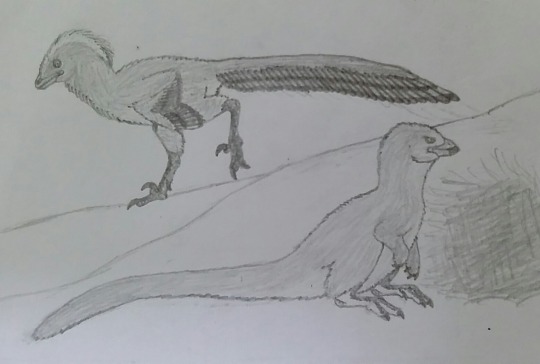
Daliansaurus & Changmiania, the big talon with sleepy burrower.
16 notes
·
View notes
Photo

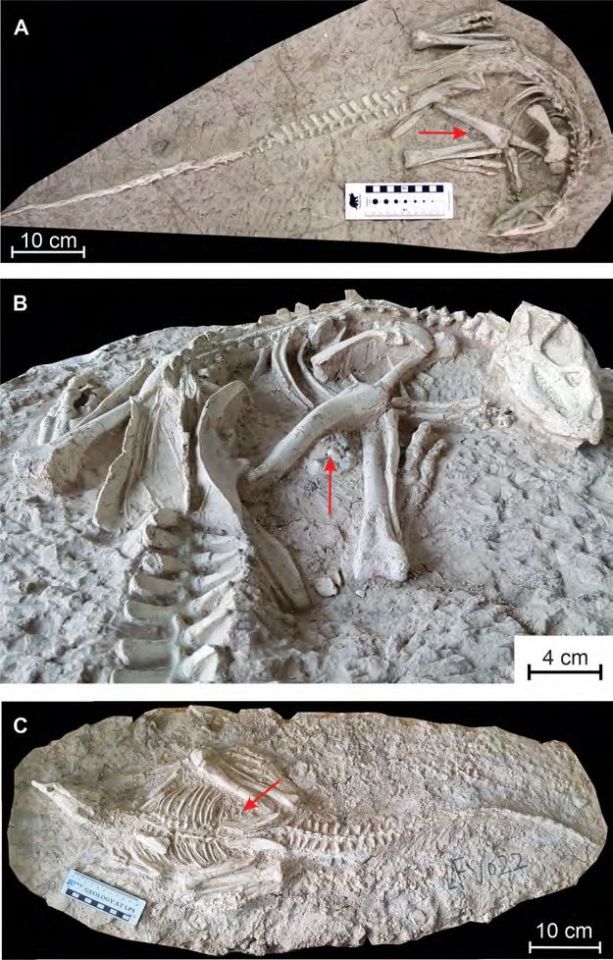
Dinosaurs Died Underground, Fossils Perfectly Preserved
Palaeontologists have described a new species of burrowing dinosaur from China. Two intact fossils of Changmiania liaoningensis suggest that the animals were trapped by a volcanic eruption while resting at the bottom of their burrows. The species just described is the most primitive ornithopod dinosaur to date, a group that also include the Bernissart Iguanodons.
The Lujiatun Beds are the oldest layers of the famous Yixian Formation, which for more than 20 years has produced several hundred beautifully preserved skeletons of feathered dinosaurs in the Liaoning Province in north-eastern China. They date back to 125 million years ago and are contemporary with the Bernissart Iguanodons, our stars here at @rbins
Eternal Sleep
Unlike the fossils found in the more recent parts of the Yixian Formation, the dinosaurs found in the Lujiatun Beds have not retained any traces of feathers; however, most of the skeletons are incredibly well preserved in three dimensions, without their bones having been moved after the death of the animal. "These animals were quickly covered by fine sediment while they were still alive or just after their death," says palaeontologist Pascal Godefroit (Royal Belgian Institute of Natural Sciences). Some paleontologists believe that these dinosaurs were victims of a gigantic volcanic eruption. Clouds of ashes would have instantly covered the Liaoning forest dwellers. The Lujiatun Beds would have been a kind of Cretaceous 'Pompeii'.
Godefroit and his Chinese and French colleagues have just described a new genus of dinosaur based on two magnificent skeletons discovered in the Lujiatun Beds and conservated in the Liaoning Paleontological Museum in Shenyang, China. It was named Changmiania liaoningensis, Changmian meaning 'eternal sleep' in Chinese.
Early Ornithopod
It was a small, herbivorous, bipedal dinosaur, about 1.2 metres long. It is the most basal representative of ornithopods found to date. Ornithopods are a group of herbivorous, dinosaurs that flourished particularly in the Cretaceous period and which includes the Bernissart Iguanodons, as well as the hadrosaurs, or duck-billed dinosaurs. With its very powerful hind legs and long, stiff tail, Changmiania was a particularly fast runner.
“However, certain characteristics of the skeleton suggest that Changmiania could dig burrows, much like rabbits do today”, says Godefroit. “Its neck and forearms are very short but robust, its shoulder blades are characteristic of burrowing vertebrates and the top of its snout is shaped like a shovel. So we believe that both Changmiania specimens were trapped by the volcanic eruption when they were resting at the bottom of their burrows 125 million years ago.”
The study is published in the scientific journal PeerJ.
#dinosaurs#fossils#naturalsciencesbrussels#palaeontology#liaoning#ornithopod#Royal Belgian Institute of Natural Sciences
216 notes
·
View notes
Video
youtube
New episode of Through Time and Clades! In this month's news episode, we discuss hummingbird torpor, air-breathing eurypterids, and Changmiania. @killdeercheer also reviews the documentary My Octopus Teacher and the book Humankind: A Hopeful History.
43 notes
·
View notes
Photo


Two perfectly preserved specimens of a new species of burrowing dinosaur have been discovered in China. Because these specimens are so well preserved, the two fossils of Changmiania liaoningensis suggest that they were trapped by a volcanic eruption while resting at the bottom of their burrows 125 million years ago. The newly described species is the most primitive ornithopod dinosaur to date, a group that also includes Bernissart Iguanodons.
Its neck and forearms were very short, but robust, and its shoulder blades were characteristic of rabbits and other burrowing vertebrates. The top of its snout was shaped like a shovel.
13 notes
·
View notes
Text
Round One: Sanxiasaurus vs Changmiania
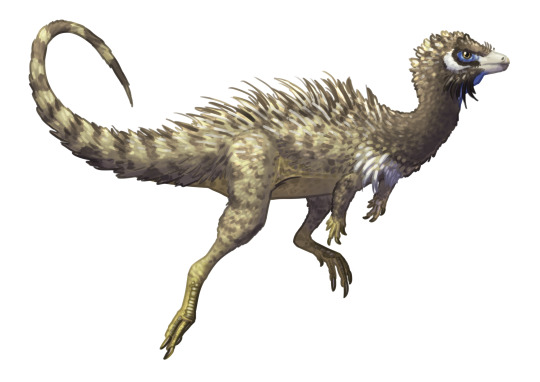

Factfiles:
Sanxiasaurus modaoxiensis

Artwork by @i-draws-dinosaurs, written by @i-draws-dinosaurs
Meaning: Sanxia lizard (after the Three Gorges of the Yangtze River) from Modaoxi (first tributary of the Yangtze)
Time: 170 million years (possibly Aalenian stage of the Middle Jurassic)
Location: Xintiangou Formation, Chongqing, China
Sanxiasaurus is a little ornithischian dinosaur named in 2019. Specifically, it’s a basal neornithischian, a group whose name has been known to induce spontaneous headaches among palaeontologists. Neornithischia is the group that includes ceratopsians, hadrosaurs, and many earlier forms, but the base of the group contains a whole truckload of little scampery bipedal critters who have proven very difficult to organise into a stable family tree. Sanxiasaurus seems to be one of the most basal of the group, and is actually the oldest ornithischian currently known from Asia! Living in the Xintiangou Formation, Sanxiasaurus shared its environment with lungfish, ray finned fish, sharks, temnospondyls, saruopterygians, crocodyliformes, turtles, and the theropod Yunyangosaurus, which was probably its main predator.
Changmiania liaoningensis

Artwork by @i-draws-dinosaurs, written by @zygodactylus
Name Meaning: Eternal Sleeper from Liaoning
Time: 125.755 million years ago (Barremian stage of the Early Cretaceous)
Location: Lujiatun Beds, Yixian Formation, Liaoning, China
Changmiania is a gorgeously preserved ornithopod known from the earliest time of the famed Yixian Formation, adding it to the ranks of amazing fossils known from this unique preservational environment. The multiple specimens of this species are found in sleeping poses, curled up on the ground with their legs and arms tucked up against them. This indicates they had been buried alive, possibly inside their own burrows. Given the depositional environment of Yixian is a sort of prehistoric Pompeii, with many dinosaurs covered very quickly in ash and dust from an exploding volcano, this makes a certain degree of sense - perhaps the two little dinosaurs had scurried into their burrow to escape the oncoming tragedy (sorry if I just made you sad), or had been asleep and unaware of the oncoming danger. At only one meter long and less than half a meter tall, Changmiania would have been easily missed in its environment, hiding among the dense vegetation from potential predators. With robust leg bones, it would have been a fast runner, able to move efficiently through the crowded undergrowth. It had a weirdly short neck for ornithischians, and that combined with its short forearms and hands indicates it was fossorial - ie, a digging animal, hence its burrow home and final resting place. Given they were found together, they were probably social creatures as well, living in small family groups. The Yixian was a dense temperate forest, filled with freshwater lakes and a great diversity of plantlife. Conifers, ferns, cycads, horsetails, and early flowering plants filled the environment and indicated a humid, possibly rainforest environment. Periodic wildfires, noxious lake gasses, and volcanic eruptions all lead to regular moments of rapid burial and amazing preservation in this environment - essentially giving us snapshots of how it changed over the course of many millions of years. In the Lujiatun bed specifically, Changmiania was neighbors with Euhelopus, Jeholosaurus, Liaoceratops, Psittacosaurus, Liaoningornis, Daliansaurus, Graciliraptor, Mei, Sinovenator, Sinusonasus, Dilong, Hexing, Incisivosaurus, Shenzhousaurus, and outside of dinosaurs mammals such as Acristatherium, Gobiconodon, Juchilestes, Maotherium, Meemannodon, and Repenomamus (yes, THAT Repenomamus), and the toad Liaobatrachus.
DMM Round One Masterpost
#dmm#dinosaur march madness#dmm round one#dmm rising stars#palaeoblr#dinosaurs#paleontology#bracket#march madness#polls#sanxiasaurus#changmiania
233 notes
·
View notes
Link
About 125 million years ago, two dinosaurs that had likely dozed off in an underground burrow drew their last breaths before they were buried alive, possibly by a volcanic eruption, a new study finds.
The pristinely preserved remains of these two nearly 4-foot-long (1.1 meters) reptiles looked so serene that researchers named the newly discovered species Changmiania liaoningensis, which means "eternal sleeper from Liaoning" in Chinese.
3 notes
·
View notes
Text
The Dinosaurs That Slept For Eternity
Two intact fossils of Changmiania liaoningensis suggest that the animals were trapped by a volcanic eruption while resting at the bottom of their burrows. The Dinosaurs That Slept For Eternity syndicated from https://triviaqaweb.wordpress.com/feed/
0 notes
Text
New 'eternal sleeper' dinosaur species was entombed while still alive
New ‘eternal sleeper’ dinosaur species was entombed while still alive
[ad_1]
About 125 million years ago, two dinosaurs that had likely dozed off in an underground burrow drew their last breaths before they were buried alive, possibly by a volcanic eruption, a new study finds.
The pristinely preserved remains of these two nearly 4-foot-long (1.1 meters) reptiles looked so serene that researchers named the newly discovered species Changmiania liaoningensis, which…
View On WordPress
0 notes
Text
Round Four: Changmiania vs Jakapil
Changmiania liaoningensis
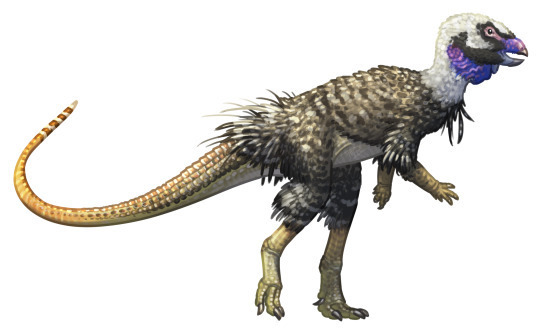
Artwork by @i-draws-dinosaurs, written by @zygodactylus
Name Meaning: Eternal Sleeper from Liaoning
Time: 125.755 million years ago (Barremian stage of the Early Cretaceous)
Location: Lujiatun Beds, Yixian Formation, Liaoning, China
Changmiania is a gorgeously preserved ornithopod known from the earliest time of the famed Yixian Formation, adding it to the ranks of amazing fossils known from this unique preservational environment. The multiple specimens of this species are found in sleeping poses, curled up on the ground with their legs and arms tucked up against them. This indicates they had been buried alive, possibly inside their own burrows. Given the depositional environment of Yixian is a sort of prehistoric Pompeii, with many dinosaurs covered very quickly in ash and dust from an exploding volcano, this makes a certain degree of sense - perhaps the two little dinosaurs had scurried into their burrow to escape the oncoming tragedy (sorry if I just made you sad), or had been asleep and unaware of the oncoming danger. At only one meter long and less than half a meter tall, Changmiania would have been easily missed in its environment, hiding among the dense vegetation from potential predators. With robust leg bones, it would have been a fast runner, able to move efficiently through the crowded undergrowth. It had a weirdly short neck for ornithischians, and that combined with its short forearms and hands indicates it was fossorial - ie, a digging animal, hence its burrow home and final resting place. Given they were found together, they were probably social creatures as well, living in small family groups. The Yixian was a dense temperate forest, filled with freshwater lakes and a great diversity of plantlife. Conifers, ferns, cycads, horsetails, and early flowering plants filled the environment and indicated a humid, possibly rainforest environment. Periodic wildfires, noxious lake gasses, and volcanic eruptions all lead to regular moments of rapid burial and amazing preservation in this environment - essentially giving us snapshots of how it changed over the course of many millions of years. In the Lujiatun bed specifically, Changmiania was neighbors with Euhelopus, Jeholosaurus, Liaoceratops, Psittacosaurus, Liaoningornis, Daliansaurus, Graciliraptor, Mei, Sinovenator, Sinusonasus, Dilong, Hexing, Incisivosaurus, Shenzhousaurus, and outside of dinosaurs mammals such as Acristatherium, Gobiconodon, Juchilestes, Maotherium, Meemannodon, and Repenomamus (yes, THAT Repenomamus), and the toad Liaobatrachus.
Jakapil kaniukura

Artwork by @i-draws-dinosaurs, written by @zygodactylus
Name Meaning: Deep Jawed Shield Bearer
Time: 99 to 97 million years ago (Cenomanian stage of the Late Cretaceous)
Location: Candeleros Formation, Neuquen and Mendoza, Argentina
Jakapil is to nonavian dinosaurs as Annakacygna is to birds. This may seem extreme - what could possibly top the cup zoomy swan of filter feeding death - but Jakapil is a weird little dude. It was a bipedal armored dinosaur, similar to the Early Jurassic basal form Scutellosaurus - except, you’ll note, it lived a hundred million years later. At about 1.5 meters long, it was a small dinosaur, again similar to its relative from so long ago. It had rows of osteoderms on its body, and a predentary - unlike other early thyreophorans. It may have diverged from the main thyreophoran group in the Sinemurian, representing a lost lineage of bipedal armored forms that persisted (presumably in South America). However, its classification is a major debate among researchers - many features of the jaw are more similar to Ceratopsians than to Thyreophorans, indicating it may be an armored variant of an early Ceratopsian (which, would be, to say the least, wild) or a completely new clade of Ornithischian altogether! The large amount of wear on its teeth indicates it chewed its food, rather than sheering or chopping it - something only found in a few Ornithischian groups. It lived in a large desert environment, peppered with oases, and filled with a variety of other animals - fish, frogs, tuatara, snakes, turtles, mammals, and other dinosaurs like Andesaurus, Ekrixinatosaurus, Giganotosaurus, Buitreraptor, Alnashetri, and Bicentenaria.
#dmm#dmm rising stars#dinosaur march madness#dinosaurs#birds#birblr#palaeoblr#paleontology#march madness#bracket#polls#changmiania#jakapil#round four
122 notes
·
View notes
Text
Round Three: Changmiania vs Bisticeratops
Changmiania liaoningensis

Artwork by @i-draws-dinosaurs, written by @zygodactylus
Name Meaning: Eternal Sleeper from Liaoning
Time: 125.755 million years ago (Barremian stage of the Early Cretaceous)
Location: Lujiatun Beds, Yixian Formation, Liaoning, China
Changmiania is a gorgeously preserved ornithopod known from the earliest time of the famed Yixian Formation, adding it to the ranks of amazing fossils known from this unique preservational environment. The multiple specimens of this species are found in sleeping poses, curled up on the ground with their legs and arms tucked up against them. This indicates they had been buried alive, possibly inside their own burrows. Given the depositional environment of Yixian is a sort of prehistoric Pompeii, with many dinosaurs covered very quickly in ash and dust from an exploding volcano, this makes a certain degree of sense - perhaps the two little dinosaurs had scurried into their burrow to escape the oncoming tragedy (sorry if I just made you sad), or had been asleep and unaware of the oncoming danger. At only one meter long and less than half a meter tall, Changmiania would have been easily missed in its environment, hiding among the dense vegetation from potential predators. With robust leg bones, it would have been a fast runner, able to move efficiently through the crowded undergrowth. It had a weirdly short neck for ornithischians, and that combined with its short forearms and hands indicates it was fossorial - ie, a digging animal, hence its burrow home and final resting place. Given they were found together, they were probably social creatures as well, living in small family groups. The Yixian was a dense temperate forest, filled with freshwater lakes and a great diversity of plantlife. Conifers, ferns, cycads, horsetails, and early flowering plants filled the environment and indicated a humid, possibly rainforest environment. Periodic wildfires, noxious lake gasses, and volcanic eruptions all lead to regular moments of rapid burial and amazing preservation in this environment - essentially giving us snapshots of how it changed over the course of many millions of years. In the Lujiatun bed specifically, Changmiania was neighbors with Euhelopus, Jeholosaurus, Liaoceratops, Psittacosaurus, Liaoningornis, Daliansaurus, Graciliraptor, Mei, Sinovenator, Sinusonasus, Dilong, Hexing, Incisivosaurus, Shenzhousaurus, and outside of dinosaurs mammals such as Acristatherium, Gobiconodon, Juchilestes, Maotherium, Meemannodon, and Repenomamus (yes, THAT Repenomamus), and the toad Liaobatrachus.
Bisticeratops froeseorum

Artwork by sauriazoicillus, written by @zygodactylus
Name Meaning: Froese’s Dééł Náázíní Horned Face
Time: 74 million years ago (Campanian stage of the Late Cretaceous)
Location: Farmington Member, Kirtland Formation, New Mexico, United States
Bisticeratops is an early Chasmosaurine, known from a partial skull found in the Kirtland Formation. Yet another of a largely growing number of Chasmosaurine taxa from the Campanian of North America, it appeared to resemble Pentaceratops, but was more closely related to later ceratopsians known from the Kirtland formation, as well as one unnamed taxon from the Almond Formation in Wyoming. Interestingly, Bisticeratops shows signs of bite marks from tyrannosaurids, which apparently had begun to heal prior to death. However, we do not know which tyrannosaurid may have left these marks - while the Kirtland Formation is a well studied environment, the Farmington Member has never yielded dinosaurian fossils before now, taking place earlier than the more famous De-Na-Zin of the formation. Like other iterations, the Kirtland was a coastal plain along the western interior seaway, preserving a muddy and sandy environment that would have been filled with a variety of subtropical plants. It is presumable that other dinosaurs lived here besides Bisticeratops and a tyrannosaurid - hadrosaurs, ankylosaurs, pachycephalosaurs, ornithomimosaurs, and dromaeosaurs would all have been possible members of this ecosystem based on the following and preceding ones from this formation.
#dmm#dmm rising stars#dinosaur march madness#dinosaurs#birds#palaeoblr#birblr#bracket#polls#march madness#paleontology#changmiania#round three#bisticeratops
92 notes
·
View notes
Text
Round Two: Changmiania vs Sinocephale
Changmiania liaoningensis

Artwork by @i-draws-dinosaurs, written by @zygodactylus
Name Meaning: Eternal Sleeper from Liaoning
Time: 125.755 million years ago (Barremian stage of the Early Cretaceous)
Location: Lujiatun Beds, Yixian Formation, Liaoning, China
Changmiania is a gorgeously preserved ornithopod known from the earliest time of the famed Yixian Formation, adding it to the ranks of amazing fossils known from this unique preservational environment. The multiple specimens of this species are found in sleeping poses, curled up on the ground with their legs and arms tucked up against them. This indicates they had been buried alive, possibly inside their own burrows. Given the depositional environment of Yixian is a sort of prehistoric Pompeii, with many dinosaurs covered very quickly in ash and dust from an exploding volcano, this makes a certain degree of sense - perhaps the two little dinosaurs had scurried into their burrow to escape the oncoming tragedy (sorry if I just made you sad), or had been asleep and unaware of the oncoming danger. At only one meter long and less than half a meter tall, Changmiania would have been easily missed in its environment, hiding among the dense vegetation from potential predators. With robust leg bones, it would have been a fast runner, able to move efficiently through the crowded undergrowth. It had a weirdly short neck for ornithischians, and that combined with its short forearms and hands indicates it was fossorial - ie, a digging animal, hence its burrow home and final resting place. Given they were found together, they were probably social creatures as well, living in small family groups. The Yixian was a dense temperate forest, filled with freshwater lakes and a great diversity of plantlife. Conifers, ferns, cycads, horsetails, and early flowering plants filled the environment and indicated a humid, possibly rainforest environment. Periodic wildfires, noxious lake gasses, and volcanic eruptions all lead to regular moments of rapid burial and amazing preservation in this environment - essentially giving us snapshots of how it changed over the course of many millions of years. In the Lujiatun bed specifically, Changmiania was neighbors with Euhelopus, Jeholosaurus, Liaoceratops, Psittacosaurus, Liaoningornis, Daliansaurus, Graciliraptor, Mei, Sinovenator, Sinusonasus, Dilong, Hexing, Incisivosaurus, Shenzhousaurus, and outside of dinosaurs mammals such as Acristatherium, Gobiconodon, Juchilestes, Maotherium, Meemannodon, and Repenomamus (yes, THAT Repenomamus), and the toad Liaobatrachus.
Sinocephale bexelli
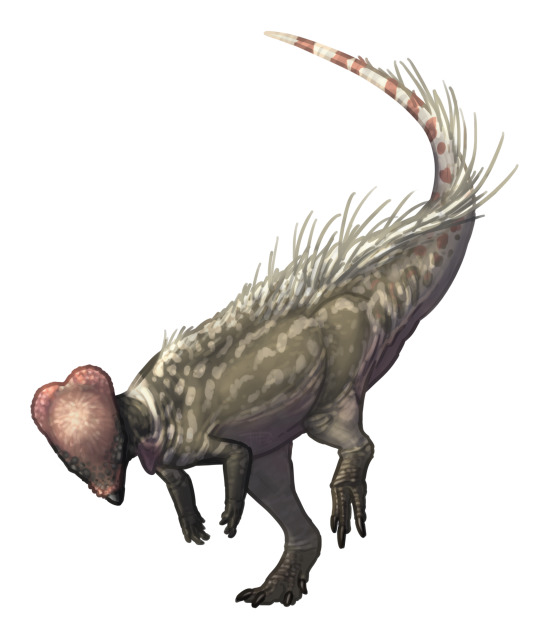
Artwork by @i-draws-dinosaurs, written by @zygodactylus
Name Meaning: Bexel’s Chinese Head
Time: 92 million years ago (Cenomanian stage of the Late Cretaceous)
Location: Ulansuhai Formation, Inner Mongolia, China
Sinocephale is an interesting case of a previously named dinosaur being renamed - and then given a new one altogether! Though originally discovered in the early 20th century and lumped into Troodon (pachycephalosaurs used to be considered Troodontids, don’t worry about it), and then shoved into Stegoceras when that whole nonsense got fixed. Unfortunately, Sinocephale really doesn’t resemble Stegoceras much at all! Shoved into dubious or not properly named genera for the petter part of multiple decades, it was only recently that it was studied and raised as a holotype for a new genus - Sinocephale! As a pachycephalosaur, it was a small bipedal animal, with a weirdly hyper-stiffened tail, and a dome on its head. Interestingly for Sinocephale, that dome was shaped like a heart (from above)! This is the distinct trait that distinguishes Sinocephale from its relatives. It was not closely related to Stegoceras at all, but closer to Sphaerotholus and the Pachycephalosaurus group. While Sinocephale lived in a somewhat poorly understood geological formation, we do know it lived alongside other dinosaurs such as Shaochilong, Sinornithomimus, and Chilantaisaurus, as well as some turtles.
#dmm#dinosaur march madness#dinosaurs#birds#dmm rising stars#dmm round two#birblr#palaeoblr#paleontology#bracket#march madness#polls#changmiania#sinocephale
82 notes
·
View notes